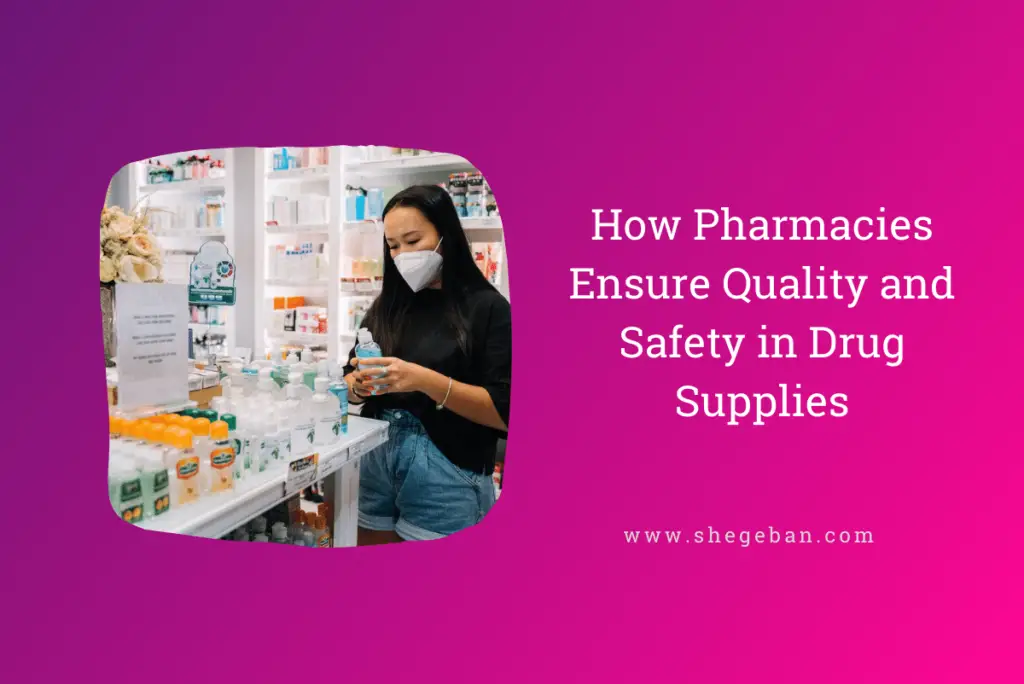Running a pharmacy takes more than just simply stocking shelves and dispensing medication. Pharmacists are in charge of ensuring that their establishments have only the best drugs and medical equipment, with customer safety being paramount.
Understandably, pharmacies undergo stringent procedures to ensure their consumers receive safe and dependable medications. However, how do pharmacies guarantee safety?
The actions taken by pharmacists to ensure that drugs and medical supplies are of the highest caliber are listed below.
- Look for Legitimate Sources
- Properly Store Drugs
- Educate Customers on Drug Use and Safety Guidelines
- Check Expiration Dates
- Monitor and Track Drug Supplies
- Ensure Accurate Labeling
- Adhere to Professional Standards
- Conduct Regular Inspections and Audits
- Educate Customers on Drug Use and Safety Guidelines
- Final Thoughts
Look for Legitimate Sources
Utilizing reliable sources for your medication is the first step in assuring its quality and safety. This implies that pharmacies must only get their medications from authorized wholesalers, producers, and distributors. By doing this, pharmacists can be confident that the drugs are genuine and safe.
Additionally, some pharmacies could develop connections with regional drug producers to ensure that the medications they get are of the greatest caliber. Additionally, pharmacies should check whether their suppliers have a history of peddling fake or outdated drugs.
All these precautions guarantee that pharmacies only carry trustworthy and secure medications in their pharmacies!
Properly Store Drugs
After purchasing the drugs, a pharmacy must properly keep them. Drugs should be kept in separate refrigerators and shelves in pharmacies so that the expiration dates can be monitored. Ensuring no contamination from other chemicals or food products in the storage room is another important aspect of appropriate pharmaceutical storage.
Also, pharmacists must know the varied humidity and temperature ranges required for particular drugs. For instance, some medications must be kept under carefully regulated frigid temperatures.
Drugs may be kept at the proper temperature for a more extended period, increasing the likelihood that patients will get safe and efficient treatments.
Educate Customers on Drug Use and Safety Guidelines
Apart from stocking and storing medications, pharmacies also guarantee safety by educating customers on the proper use of drugs. Pharmacists should be able to provide advice on how to take medication safely, as well as the potential side effects of certain drugs.
Also, pharmacists can also advise customers on where to get their medicines at more affordable prices. For example, customers with acidic stomachs might be recommended to buy protonix.
To save on protonix with average prices: $13.96, customers can get their medications from pharmacies that offer discounts and coupons. By offering helpful advice like this, pharmacists help ensure that customers use their drugs correctly and safely.
Check Expiration Dates
Another step in a pharmacy’s quality assurance process is to check expiration dates. Pharmacists should always double-check the expiry date of every medication before selling it, as medications become less effective or even dangerous when used after their expiration date.
Pharmacies should also keep track of their stock regularly and discard any medicines close to their expiry date. This helps ensure that customers are not given expired medications and that any dangerous drugs are appropriately disposed of.
Monitor and Track Drug Supplies
Monitoring and tracking the pharmaceuticals sent to a pharmacy is essential in the quality assurance. A single location should be used to track all of a pharmacy’s supplies.
Doing so makes it possible to guarantee the security of medicines and prevent the hoarding or shortage of vital medications. Additionally, it allows pharmacists to monitor any drugs that have been stolen or are counterfeit.
Ensure Accurate Labeling
It’s crucial to check sure drug labels are correct. The pharmacy personnel should double-check the names, dosages, and quantities of the prescriptions on the labels. When labeling pharmaceuticals, there are precise rules that must be observed.
Accurate labeling aids consumers in choosing the right medications and ensuring they are used as directed. For instance, some medications may need to be marked with a warning label if they are harmful, while others may need to be labeled with “keep out of reach of children.”
Adhere to Professional Standards
Pharmacies should adhere to professional standards and regulations regarding quality assurance. This involves following the rules of governing bodies such as the Food and Drug Administration (FDA).
A good understanding of these regulations helps pharmacies ensure their patients receive safe medication and avoid legal trouble. Professional standards refer to a pharmacy’s ethical behavior, transparency, and accountability in providing quality services.
Conduct Regular Inspections and Audits
While most pharmacies do routine audits and inspections of their inventory, going the extra mile can assist in guaranteeing that quality assurance is up to par. The pharmacy staff can look for outdated medications or drug interactions through routine inspections.
Audits, on the other hand, guarantee that pharmacies adhere to all rules and procedures. Customers will receive the finest service possible thanks to this helping to guarantee that quality assurance is handled seriously. Additionally, it aids pharmacists in determining which aspects of their practices require improvement.
Educate Customers on Drug Use and Safety Guidelines
The quality assurance process of a pharmacy must include educating clients about safe medicine usage and handling procedures. Any possible negative effects or drug interactions must be disclosed to customers.
Some pharmacies offer consumers written information outlining the uses and potential negative effects of the medication. Others could even have a pharmacist on hand to address any queries or worries that clients may have.
Customers properly utilizing their prescriptions are more likely to do so, which benefits the quality assurance procedure.
Final Thoughts
Running a pharmacy successfully requires quality assurance. To guarantee that clients can access safe, effective pharmaceuticals, each process step must be completed accurately and completely.
These actions must be taken seriously, from monitoring supply to conducting audits and instructing customers. As legislation and customer demand change, quality assurance is a continuous process that involves commitment and focus.






